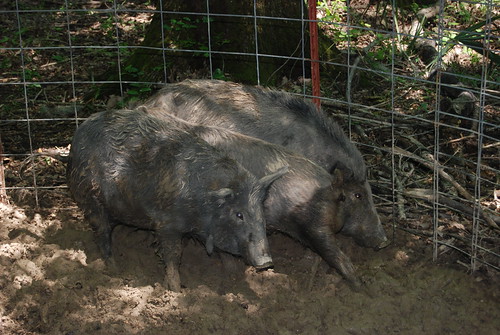
Feral swine have been called the “rototillers” of nature. Their longs snouts and tusks allow them to rip and root their way across America in search of food. Unfortunately, the path they leave behind impacts ranchers, farmers, land managers, conservationists, and suburbanites alike. April, Invasive Plant Pest and Disease Awareness Month, is a great time to learn about this serious threat to both plant and animal health.
Found in at least 35 states and with a population of more than 5 million, feral swine cause approximately $1.5 billion in damages and control costs in the United States each year, with at least $800 million of this estimate due to direct agricultural damage. The damage caused by feral swine seems endless and includes the following:
- Destroying native habitats, crops, lawns, and river banks through rooting and wallowing
- Eating and destroying agricultural crops
- Competing with native wildlife for food and other resources
- Carrying or transmitting over 30 diseases and 37 parasites
- Contaminating human food sources and water supplies
- Destroying property and fences
- Eating ground nesting birds and other small wildlife
- Consuming livestock feed and supplements and fowling water sources
- Colliding with vehicles
The APHIS Wildlife Services (WS) program collaborates with State, local and tribal officials to reduce the threats caused by feral swine to our country’s livestock, agriculture, native ecosystems, and human and animal health. Our experts provide technical advice to landowners, state agencies and others, as well as direct management assistance for feral swine problems in more than 30 states. This is often necessary because hunting alone cannot resolve feral swine conflicts with humans. WS experts provide a 3-pronged approach that involves management, disease surveillance, and research.
For instance, WS is initiating a collaborative pilot project this spring in New Mexico to eradicate feral swine from certain areas in the State and protect threatened and endangered species and their habitats. The State’s unique geographic characteristics and the size and geographic separation of the State’s feral swine population make eradication still possible. The effort will provide information and evidence to guide feral swine control efforts in many other states.
You can help be part of the solution: 1) Report feral swine activity to the proper wildlife and agriculture officials in your State; 2) Do not relocate feral swine without proper permits; and 3) if you raise domestic pigs, take adequate biosecurity measures to prevent accidental release of domestic pigs or the interaction between feral swine and domestic pigs.
USDA’s Animal and Plant Health Inspection Service (APHIS) has declared April as Invasive Plant Pest and Disease Awareness Month. Throughout the month, APHIS is posting a series of blog entries here and also share invasive plant pest and disease information through our twitter feed. APHIS and its federal and state partners are fighting to protect our communities, our public lands, and our agricultural resources from invasive species. But we can’t do it alone. Join the fight by visiting www.HungryPests.com.
